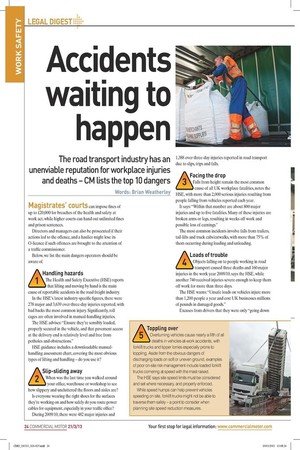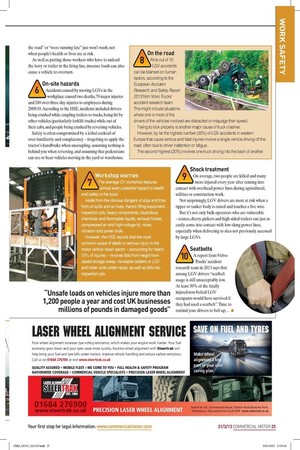Accidents waiting to happen The road transport industry has an
Page 16

Page 17

If you've noticed an error in this article please click here to report it so we can fix it.
unenviable reputation for workplace injuries and deaths CM lists the top 10 dangers Words: Brian Weathertey Magistrates' courts can impose fines of up to £20,000 for breaches of the health and safety at work act, while higher courts can hand out unlimited fines and prison sentences.
Directors and managers can also be prosecuted if their actions led to the offence, and a haulier might lose its 0-licence if such offences are brought to the attention of a traffic commissioner.
Below, we list the main dangers operators should be aware of.
Handling hazards The Health and Safety Executive (HSE) reports /Lii that lifting and moving by hand is the main cause of reportable accidents in the road freight industry.
In the HSE's latest industry-specific figures, there were 278 major and 3,639 over-three-day injuries reported, with bad backs the most common injury. Significantly, roll cages are often involved in manual-handling injuries.
The HSE advises: "Ensure they're sensibly loaded, properly secured in the vehicle, and that pavement access at the delivery end is relatively level and free from potholes and obstructions."
HSE guidance includes a downloadable manualhandling assessment chart, covering the most obvious types of lifting and handling — do you use it?
AN Slip-sliding away When was the last time you walked around your office, warehouse or workshop to see how slippery and uncluttered the floors and aisles are?
Is everyone wearing the right shoes for the surfaces they're working on and how safely do you route power cables for equipment, especially in your traffic office?
During 2009/10, there were 482 major injuries and Facing the drop Falls from height remain the most common cause of all UK workplace fatalities, notes the HSE, with more than 2,000 serious injuries resulting from people falling from vehicles reported each year.
It says: "Within that number are about 800 major injuries and up to five fatalities. Many of these injuries are broken arms or legs, resulting in weeks off work and possible loss of earnings."
The most common incidents involve falls from trailers, tail-lifts and truck cabs/catwalks, with more than 75% of them occurring during loading and unloading.
Loads of trouble Objects falling on to people working in road transport caused three deaths and 160 major injuries in the work year 2009/10, says the HSE, while another 740 received injuries severe enough to keep them off work for more than three days.
The HSE warns: "Unsafe loads on vehicles injure more than 1,200 people a year and cost UK businesses millions of pounds in damaged goods."
Excuses from drivers that they were only "going down the road" or "were running late" just won't wash, not when people's health or lives are at risk.
As well as putting those workers who have to unload the lorry or trailer in the firing line, insecure loads can also cause a vehicle to overturn. 5AToppling over Overturning vehicles cause nearly a fifth of all deaths in vehicles-at-work accidents, with forklift trucks and tipper lorries especially prone to toppling. Aside from the obvious dangers of discharging loads on soft or uneven ground, examples of poor on-site risk management include loaded forklift trucks cornering at speed with the mast raised.
The HSE says site speed limits must be considered and set where necessary, and properly enforced.
While speed humps can help prevent vehicles speeding on site, forklift trucks might not be able to traverse them safely — a point to consider when planning site speed reduction measures. On-site hazards Accidents caused by moving LGVs in the workplace caused two deaths, 79 major injuries and 249 over-three-day injuries to employees during 2009/10. According to the HSE, incidents included drivers being crushed while coupling trailers to trucks, being hit by other vehicles (particularly forklift trucks) while out of their cabs, and people being crushed by reversing vehicles. Safety is often compromised by a lethal cocktail of over-familiarity and complacency — forgetting to apply the tractor's handbrake when uncoupling, assuming nothing is behind you when reversing, and assuming that pedestrians can see or hear vehicles moving in the yard or warehouse.
Aorkshop worries The average CV workshop features almost every potential hazard to health in the book.
Aside from the obvious dangers of slips and trips from oil spills and air lines, there's lifting equipment, inspection pits, heavy components, hazardous chemicals and flammable liquids, exhaust fumes, compressed air and high-voltage kit, noise, vibration and power tools.
However, the HSE reports that the most ommon cause of death or serious injury in the otor vehicle repair sector — accounting for nearly 10% of injuries — involves falls from height from raised storage areas, moveable ladders or LGV and trailer units under repair, as well as falls into inspection pits. On the road Nine out of 10 LGV accidents can be blamed on human factors, according to the European Accident Research and Safely Report 2013 from Volvo Trucks' accident research team. This might include situations where one or more of the drivers of the vehicles involved are distracted or misjudge their speed. Failing to look properly is another major cause of truck crashes.
However, by far the highest number (35%) of LGV accidents in western Europe that cause serious and fatal injuries involve a single vehicle driving off the road, often due to driver inattention or fatigue.
The second-highest (20%) involves one truck driving into the back of another.
9AShock treatment On average, two people are killed and many more injured every year after coming into contact with overhead power lines during agricultural, utilities or construction work.
Not surprisingly, LGV drivers are most at risk when a tipper or tanker body is raised and touches a live wire.
But it's not only bulk operators who are vulnerable — cranes, cherry-pickers and high-sided trailers can just as easily come into contact with low-slung power lines, especially when delivering to sites not previously accessed by large LGVs.
Seat belts A report from Volvo Trucks' accident research team in 2013 says that among LGV drivers "seatbelt usage is still unacceptably low. At least 50% of the fatally injured non-belted LGV occupants would have survived if they had used a seatbelr. Time to remind your drivers to belt up... •






































